Предпродукција је суштински корак у планирању сваког филмског пројекта. Укључује све планирање које се дешава пре него што камере почну да раде, од размишљања о концепту, истражујући изглед вашег филма, сцене снимања сценарија и извиђачких локација. Ако сте директор, кинематограф, продуцент, или задужен за скупове, pre-production is an integral step in ensuring your crew understands the scope of the project ahead. Before you start your next short film, music video or documentary, thorough pre-production will set your film up for success.
In this guide you’ll learn the 6 essential steps of film pre-production…
StepsYou’ll learn how to…
- 1. Project plan – Set up a place to plan your project
- 2. Brainstorming – Transform an initial idea into something big
- 3. Moodboard – Organize inspiration & references
- 4. Storyboard – Visualize the key parts of your film
- 5. Shot list – Plan each shot you need
- 6. Call sheet – Organize your crew & talent
1. Project plan
Set up a place to plan your project
Traditionally, a project plan might be scattered across various emails, to-do lists, spreadsheets, and documents, making it hard to keep track of everything. A central project plan combines these artifacts into one easy-to-access place. It will evolve over the lifespan of your project but usually includes:
- The script
- Your ideas
- Inspiration and moodboards
- Storyboards
- Time and location of the shoot
- Shot lists
- Workflow checklist
- Gear checklist
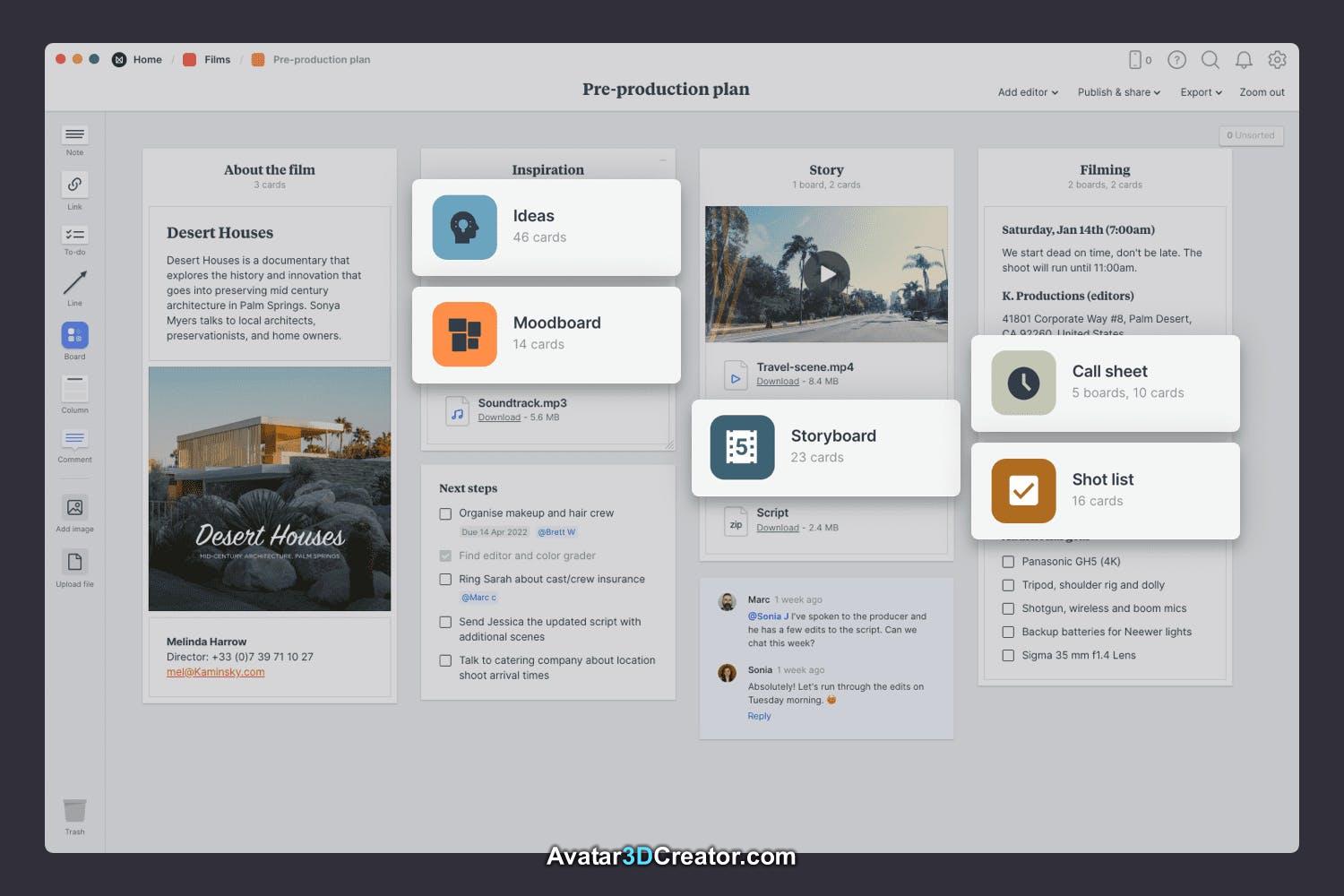
How to do this in Milanote
- Create a new board for your film project planShow me how
- Choose thePre-production Plan templateShow me how
2. Brainstorming
Transform an initial idea into something big
Every film begins life as a fleeting idea—just a spark. It’s at this stage you need to harness your creative energy and turn that idea into something real. And brainstorming is the perfect technique for the job.
Brainstorming is a classic creative technique that helps you create lots of ideas in minutes. You can use it to explore the topic for your film, dream up new characters, locations, or even the visual style you’re after. It’s best thought of as a way to light up our imagination. As ancient philosopher Plutarch said, “The mind is not a vessel to be filled, but a fire to be kindled.”

First, open the Ideas board
You’ll find the board for brainstorming on your Pre-production Plan board. Double click the Ideas board to open it and start brainstorming.

How to do this in Milanote
- Double click theIdeas board to open it.
Start with the central idea for your film
What’s the idea or concept for your film? This is your starting point. It might be just a rough idea at the moment or a topic that you want to explore, but this process will help you see how far you can take it. Add a note that describes the film in 1 до 2 sentences to get started.

How to do this in Milanote
- Add a note to describe the concept of your film.Show me how
Pro tip:
Your initial idea doesn’t need to be something groundbreaking, you’ll transform it over time. As Steven Spielberg says “All good ideas start out as bad ideas, that’s why it takes so long.”
Add as many ideas as you can
Now it’s time to get creative. Invite your team and start adding any ideas that relate to your initial concept. Think about the characters, their relationships, the locations you could use, visual styles, and the topic’s history. Explore every thread until you fill the board.
Don’t worry about evaluating your ideas yet, that will come later. Setting a timer for 5 minutes is a great way to create a sense of urgency and prevent people from judging their thoughts.

How to do this in Milanote
- Invite others to add their ideas.Show me how
- Add a note for each idea.Show me how
Add inspiring imagery, motion & sound
Sometimes it’s easier to communicate an idea with an image or video, especially if it’s a mood or style you’re trying to express. Gather reference imagery, videos and sound and add them into the mix. These can become the foundation for amoodboard as your film project evolves.
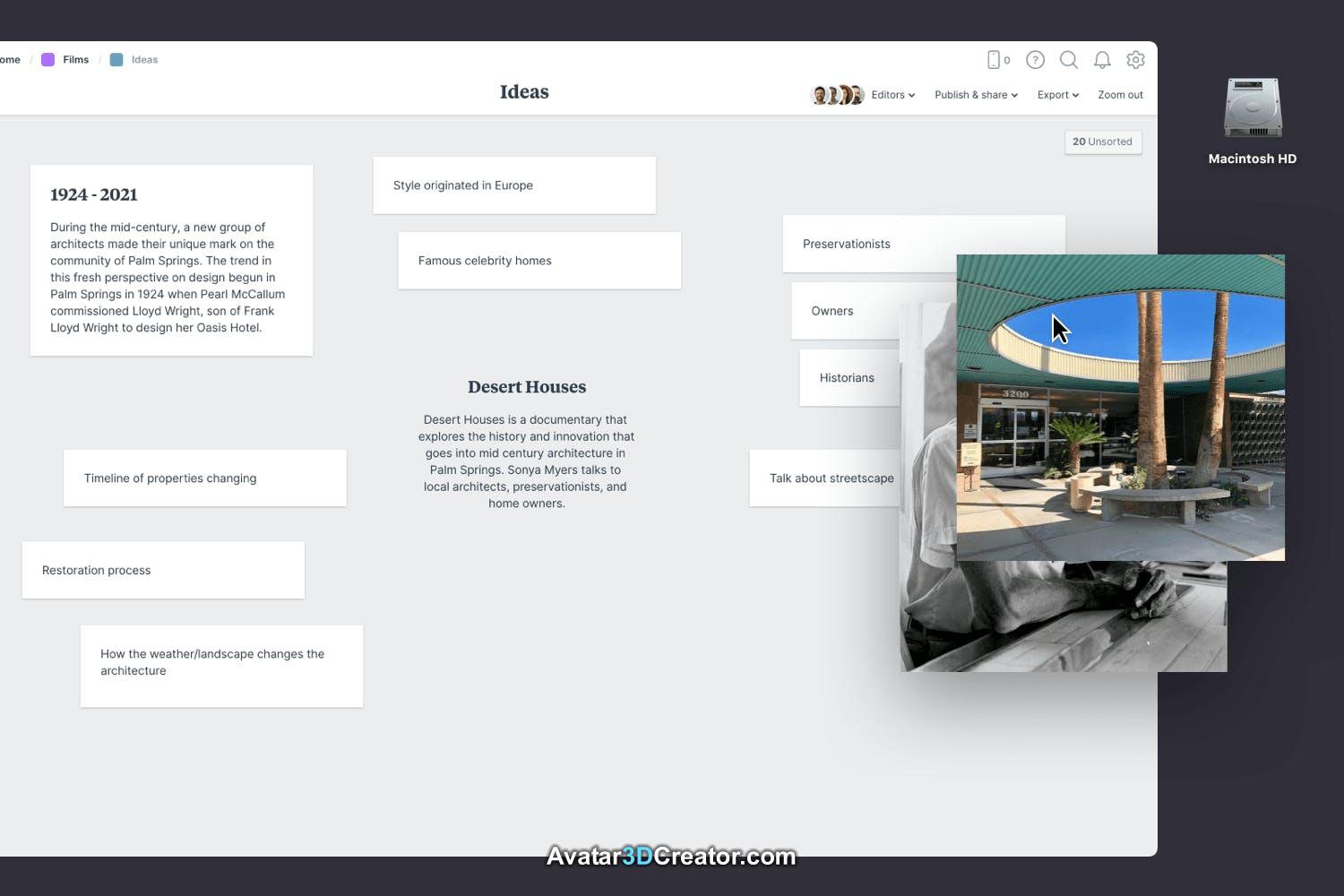
How to do this in Milanote
- Use the built-in image library.Show me how
- Drag images from your computer onto the board.Show me how
Finally, organize your ideas into themes
Once you’ve explored every idea, the next step is to make connections. This is where you see the magic of brainstorming!
Start by grouping similar ideas to uncover patterns in your thinking. Add a title to each group so it’s easy to scan. You might find your ideas fall into groups like characters, costumes, locations or aesthetics but there are no rules about how you do it.

You’re done brainstorming
Now that your brainstorming session is complete, you have a strong foundation for your film! Remember, just as creativity and inspiration is constantly evolving, so are ideas. Come back and add to the brainstorm when inspiration strikes, or refer to it as you start your script.
3. Moodboard
Organize inspiration & references
During brainstorming, you imagined the different parts of your film. It’s time to start exploring some visual directions with a moodboard.Moodboards can help you visualize any aspect of your film. You might want to focus on how the lighting or color could look. Or they could be centered around the set designs or costumes you want to use. You can create a moodboard for each of these separately or mix them all into one board. There are no strict rules.
Your moodboard will also be a fantastic reference for your team—from the director to the costume designer—it helps everyone visualize the end result.

First, open the Moodboard
You’ll find the board to make your moodboard on the Pre-production Plan board. Double click on the Moodboard to open it and start adding your inspiration.

How to do this in Milanote
- Double click theMoodboard to open it.
Collect existing material
Start by adding any existing material you have—this could include stills from previous shoots, client references or images you’ve saved as inspiration. These might not make it into the final moodboard, but they’re still a great place to start.

How to do this in Milanote
- Drag files from your computer.Show me how
Add inspiring imagery
The imagery you bring into your moodboard helps you express your film’s look and feel. Images can define things like tone, cropping, lighting and color.
You can start by saving visual references from around the web. There are lots of fantastic sites where you can find great visual inspiration for free, likeShotdeck, Instagram, orПинтерест. Don’t worry about organizing the images just yet, that step will come later.

How to do this in Milanote
- Use the built-in image library.Show me how
- Install theMilanote Web Clipper
- Save images from other websites straight to your board.Show me how
Transform your board from messy to organized
Once you have all your inspiration in one place, the next step is to arrange your ideas to create the perfect layout. Start by exploring composition and introducing hierarchy. Place a key element to anchor your board, and change the size and position of the remaining elements to indicate their importance and relationships to one another.

How to do this in Milanote
- Resize your images to add hierarchy.Show me how
- Crop images.Show me how
You’ve finished the moodboard!
Now that your moodboard is complete, you have a powerful visual reference for your film. Remember, you can create multiple moodboards to explore different directions at any time.
Next, we’ll create a storyboard to map out the key parts of your film.
4. Storyboard
Visualize the key parts of your film
Storyboards are a powerful way to visually organize the composition, action and look of a film before you start bringing it to life. As director, producer and screenwriter Martin Scorsese said, “The storyboard is the way to visualize the entire movie in advance.”
Many people devote their entire careers to storyboarding as it combines disciplines and techniques such as illustration, writing and production. Traditionally, a storyboard would be created with analog sketches, but with a modern digital tool you can use photography, animation, color and notes to highlight key characters, scenes and objects.
Storyboards aren’t just for understanding scenes; they can also be used for a variety of other reasons including:
- Visual Planning: Organize the order of a story and flow before filming.
- Pacing and Timing: Control the narrative’s speed.
- Visual Composition: Experiment with shots and angles.
- Pre-visualization: Preview complex scenes or effects.
- Resource Planning: Plan props, sets, and wardrobes more efficiently.
- Collaboration: Align efforts so the crew is working toward the same goal.
- Presentations: Convey ideas to clients, investors, and the director.
- Problem Solving: Identify and address any issues before filming starts.
- Continuity: Maintain uniformity in style and design throughout the film.

First, open the storyboard
You’ll find the empty Storyboard on the Pre-Production Plan board. Double click the Storyboard to open it and start adding the mapping out the key scenes.
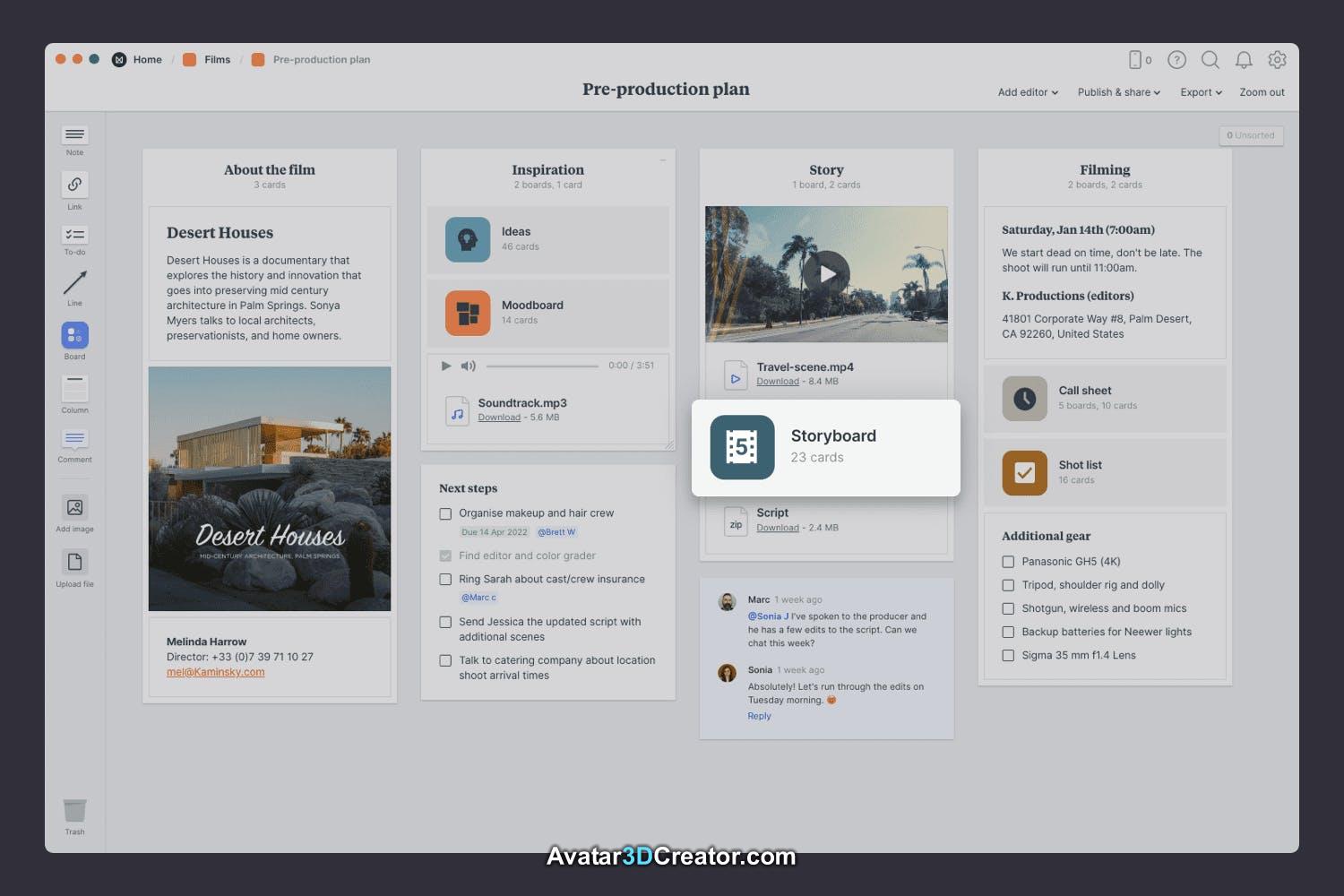
How to do this in Milanote
- Double click theStoryboard to open it.
Map out the key scenes
When creating a storyboard, it’s crucial to know what story you’re telling. They’re a great way to break up the script or narrative into pieces to understand what you’re trying to achieve when filming.
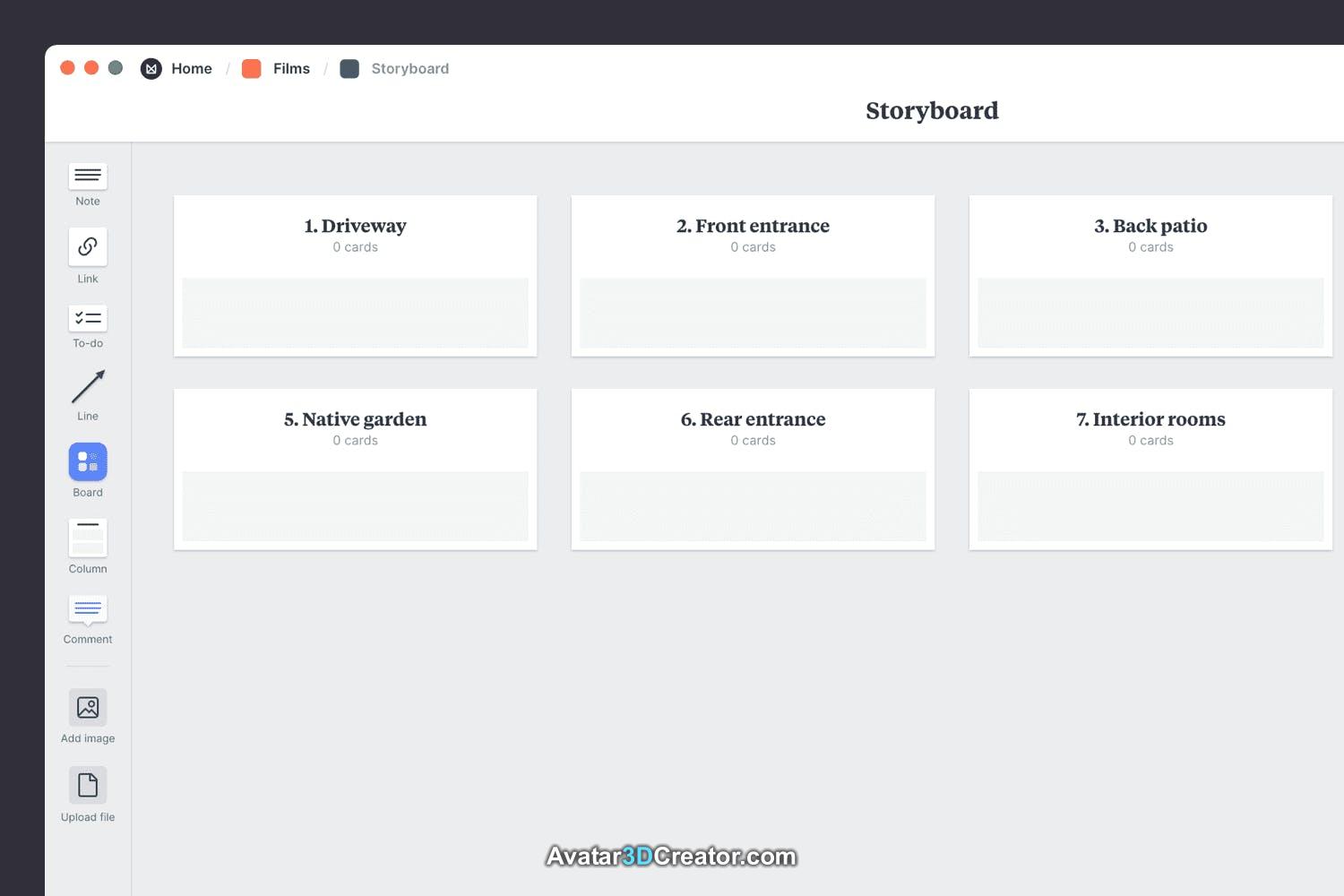
How to do this in Milanote
- Add a column for each frame.Show me how
Add images or sketches
Now it’s time to begin visualizing each scene. Some storyboard artists might begin sketching with a pen and paper first, but you can use reference photography, illustrations, screenshots, location shoots, and even motion to communicate each scene.
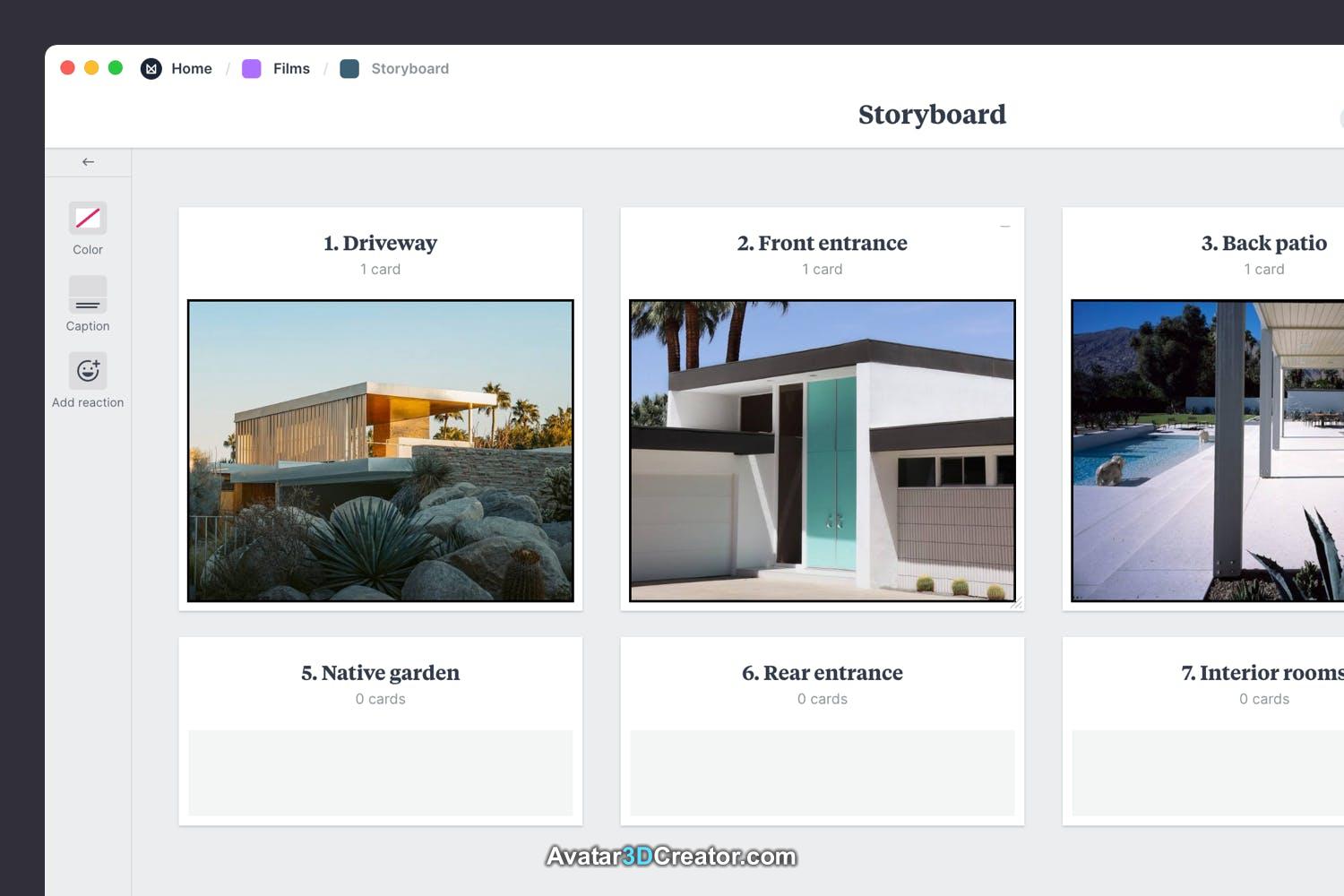
How to do this in Milanote
- Upload images for each frame.Show me how
- Use the built-in image library.Show me how
Describe what happens in each frame
While each frame is a static image, try to communicate how it’s going to look and feel as a moving sequence. Describe the style, mood, and behavior of characters. Consider how the camera will move through the shot and how you’ll transition from scene to scene. Add details about the sound to help your team imagine the emotion and drama you’re trying to capture.

How to do this in Milanote
- Add a note to describe each frame.Show me how
Share it with your team
When you’re ready, invite your team to review your storyboard and share their feedback. This is the perfect moment to see how others interpret your vision for the story. It’s also a great opportunity to make any final tweaks while in pre-production. Adjust the order of your frames or edit the content based on everyone’s feedback.
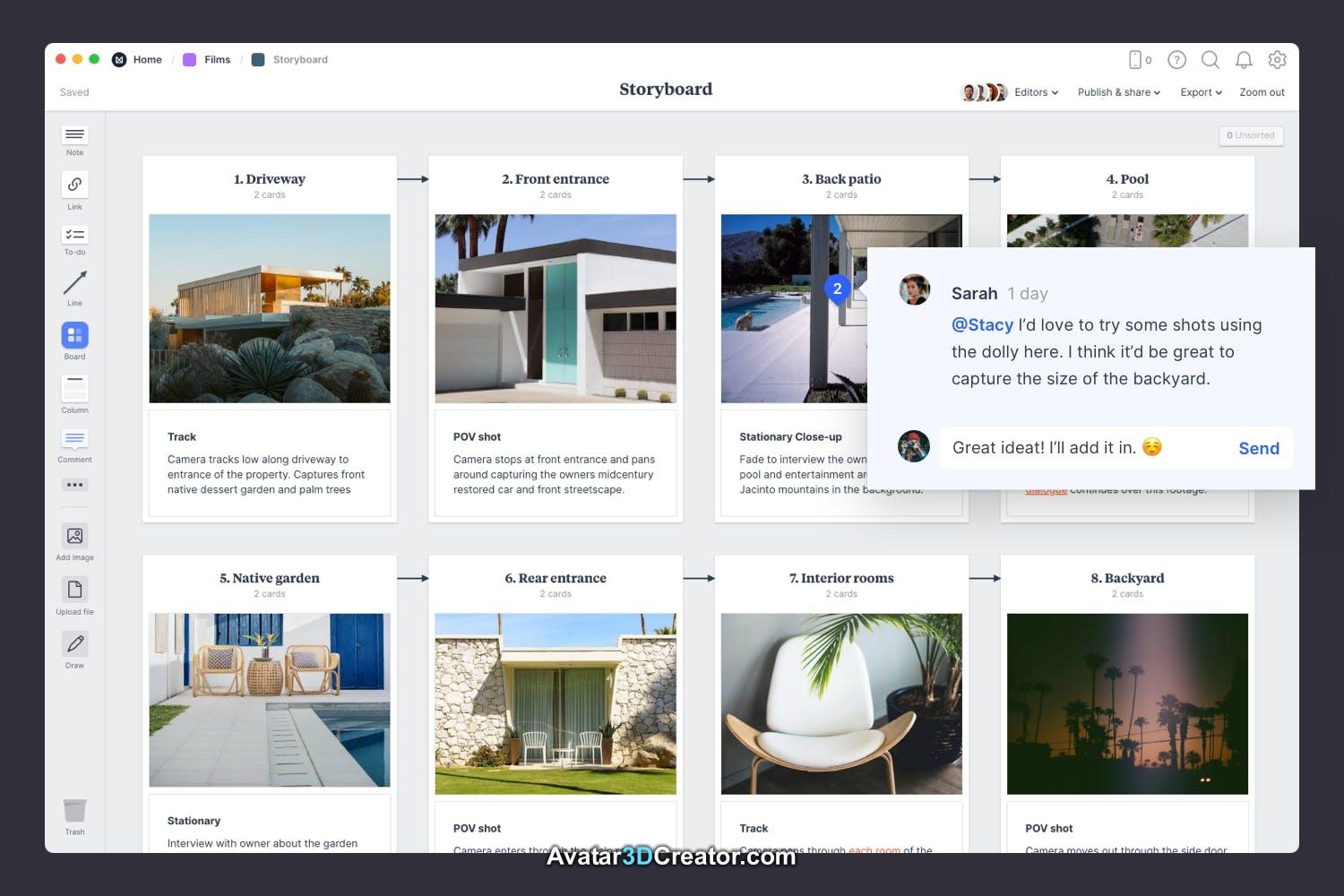
How to do this in Milanote
- Share the storyboard with your team.Show me how
- Start a comment thread.Show me how
- Mention teammates to get their attention.Show me how
Your storyboard is done!
Now that your storyboard is complete, you have a clear vision for your film! Let’s move on and create a shot list to plan the scenes you’ll shoot during production.
5. Shot list
Plan each shot you need
Coordinating a shoot can be stressful and costly, especially if that critical shot is missed on the day. But a clearly defined shot list will make sure nothing slips through the cracks.
Ashot list is a simple checklist of each shot (or scene) you need to capture on the day of a shoot. It usually contains a list of specific shots, some visual references and extra details like camera angles or lighting set-up so you don’t forget a thing.

First, open the shot list board
You’ll find the board to make your shot list on the Film plan board. Double click on the Shot List to open it and get started.
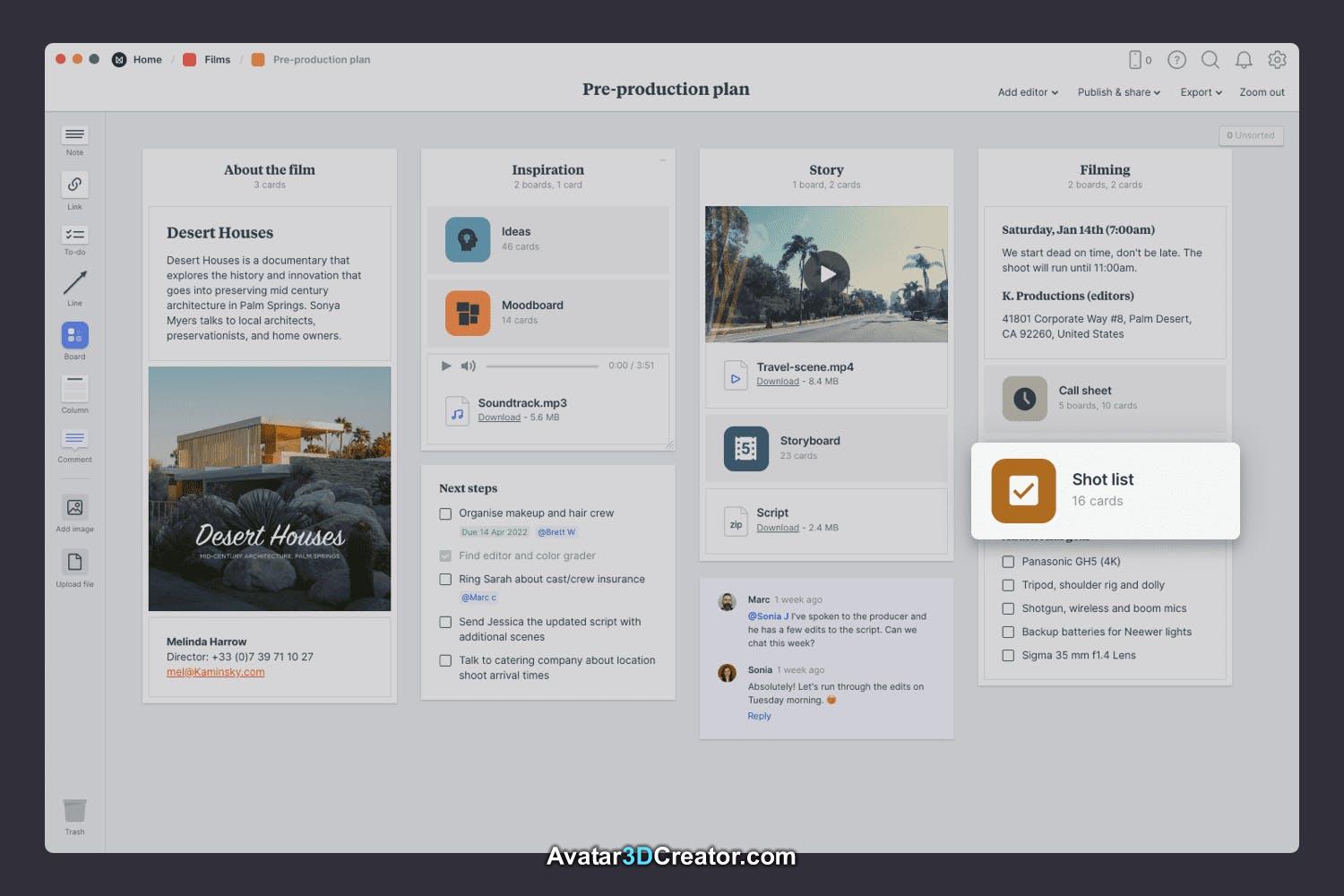
How to do this in Milanote
- Double click theShot List board to open it.
List the things you’re shooting
Start by listing the main scenes you’ll be filming. Adding reference images or sketches will make your shot list easier to scan—even if they’re just rough photos you’ve taken on your phone. It will also help your crew visualize the type of shots you’re planning to capture.

How to do this in Milanote
- Upload images to your board.Show me how
List the individual shots you need
This is the heart of the shot list. It’s where you list each individual shot you require. Some details to include are: camera angle, location, position of the camera, and shot size (how big or small the subject is in the frame).

How to do this in Milanote
- Create a new to-do list for each of the specific shots.Show me how
Add a simple gear list
What equipment will you need to shoot these scenes? Imagine being half way through filming when you realize the spare battery pack is still in the studio. Adding a simple gear list will ensure you have everything you need on the day. It’s a lifesaver!
Use theFilm Production Equipment List template if you have lots of gear to keep track of.
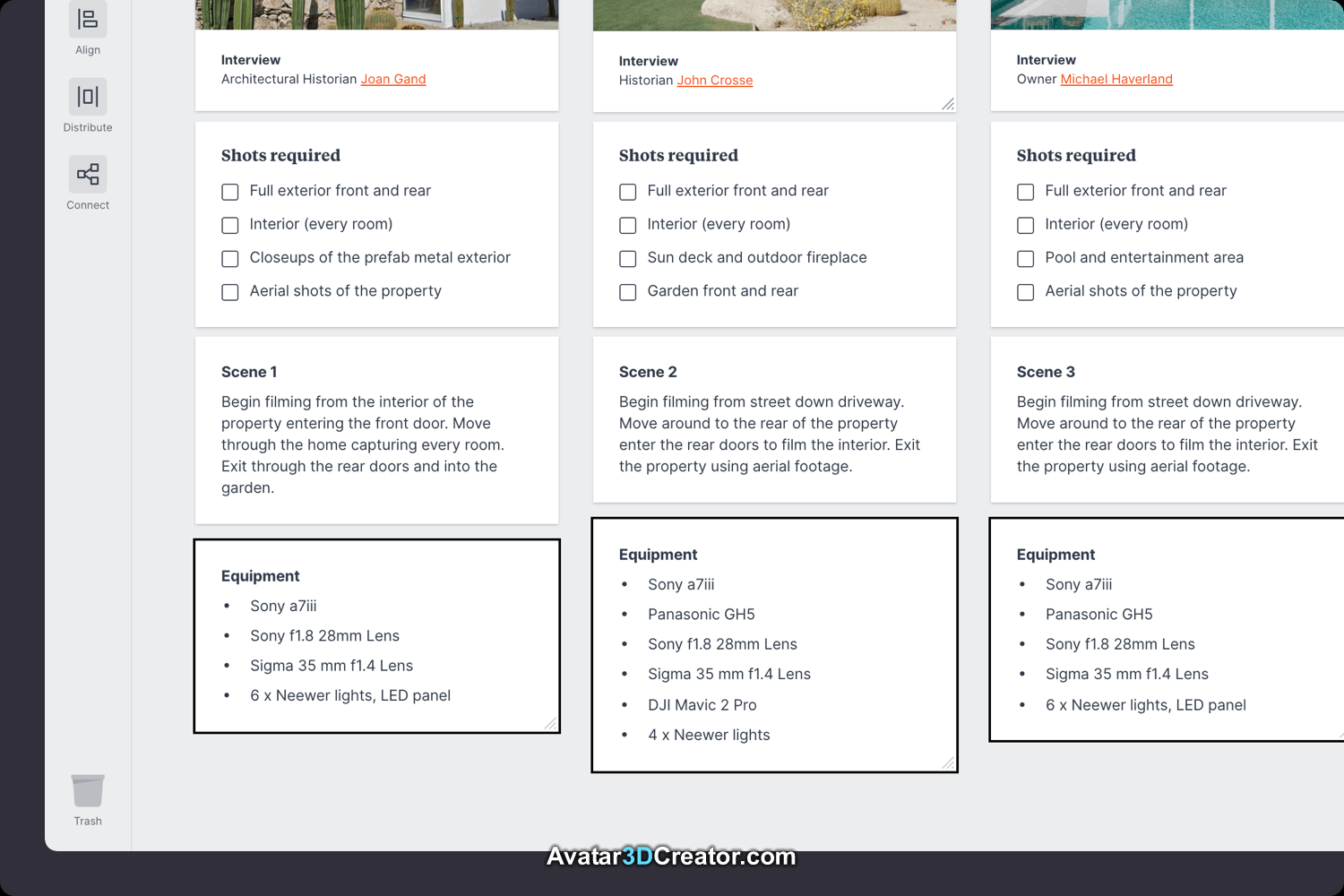
How to do this in Milanote
- Add a note to list your equipmentShow me how
Reference it on the day
Traditionally, you’d print out your shot list to refer to on the day, but digital shot lists can be accessed onphones or laptops. This way, you can check off each shot or adjust it as you need.

How to do this in Milanote
- Download the Milanote mobile app
You’ve finished the shot list!
Now that your shot list is complete, you have a clear plan for the scenes you need to capture during the shoot.
Next, we’ll create a call sheet to schedule your team…
6. Call sheet
Organize your crew & talent
You may have witnessed a disorganized shoot before—the actors were late, the crew forgot the lighting or the set wasn’t ready. One vital document was missing—the call sheet.
Thecall sheet is a simple, but incredibly useful tool for organizing your shoot. It outlines everything your talent and crew need to know before the day of the shoot. Crucial elements like the location, contact details, the schedule, and most importantly the arrival time.
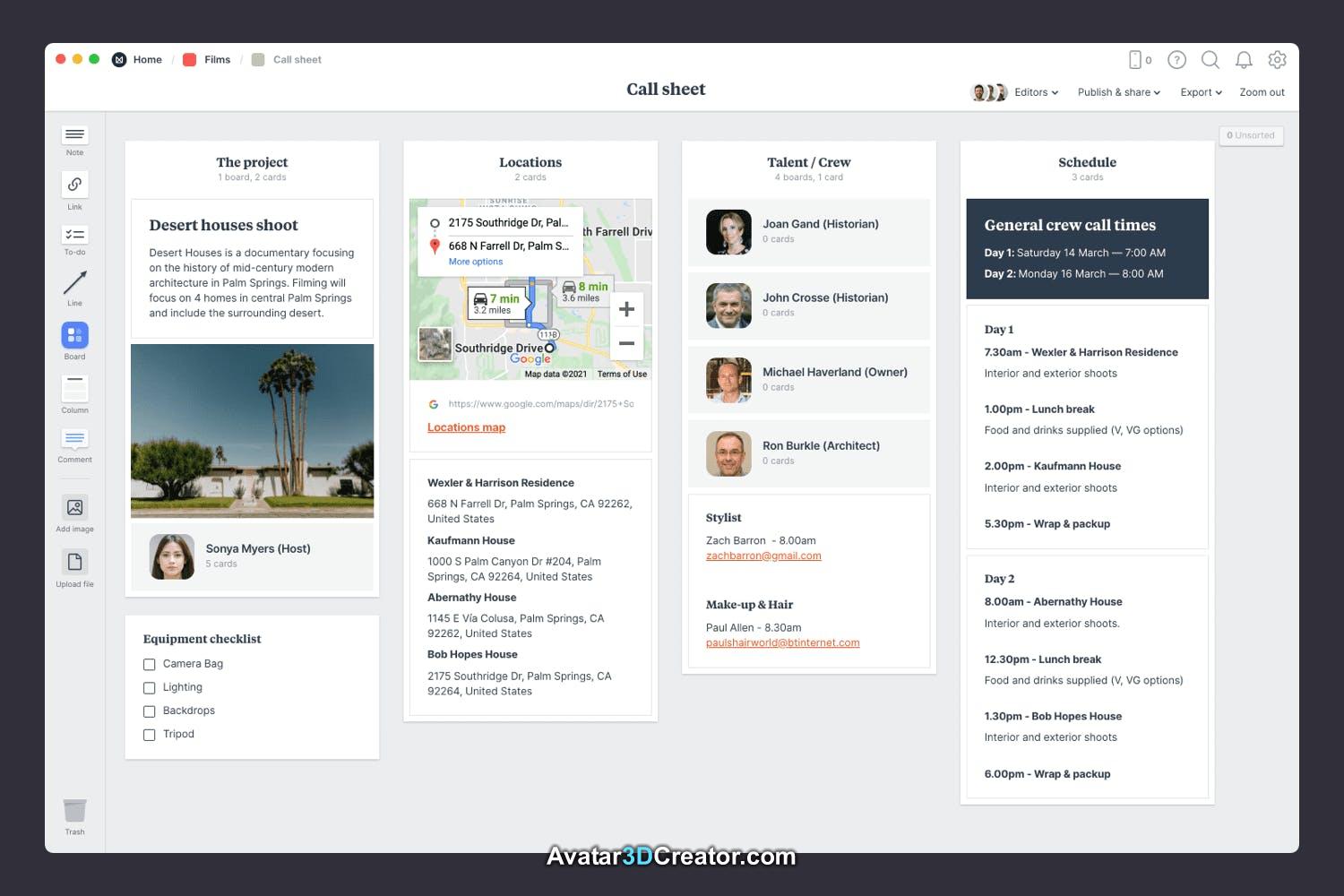
First, open the Call Sheet board
You’ll find the board to make your call sheet on the Pre-production Plan board. Double click on the Call Sheet to open it and start laying out a plan for the day of the shoot.

How to do this in Milanote
- Double click theCall Sheet board to open it.
Add the location and background information
Add background information about the shoot for your talent and crew. Next, add the location of the shoot and any details that will help people arrive safely and on time. Explain where the parking options are, nearby public transport and any details about to get into the building.

How to do this in Milanote
- Add a note to describe the project.Show me how
- Embed a Google map to show the location.Show me how
List your talent & crew
Who’s involved in your shoot? List your talent and crew along with their contact details. This will save you hunting around for phone numbers when plans inevitably change on the day. Next, add any specific arrival times so each person knows exactly when they’re expected.

How to do this in Milanote
- Add a note for the details of your crew.Show me how
Outline the schedule
Probably the most important part is the schedule—specifically the general crew call time. The general crew call time is when everyone needs to arrive on location. Under this, add the key events for the day so everyone can clearly see what’s on and when. Don’t forget lunch!
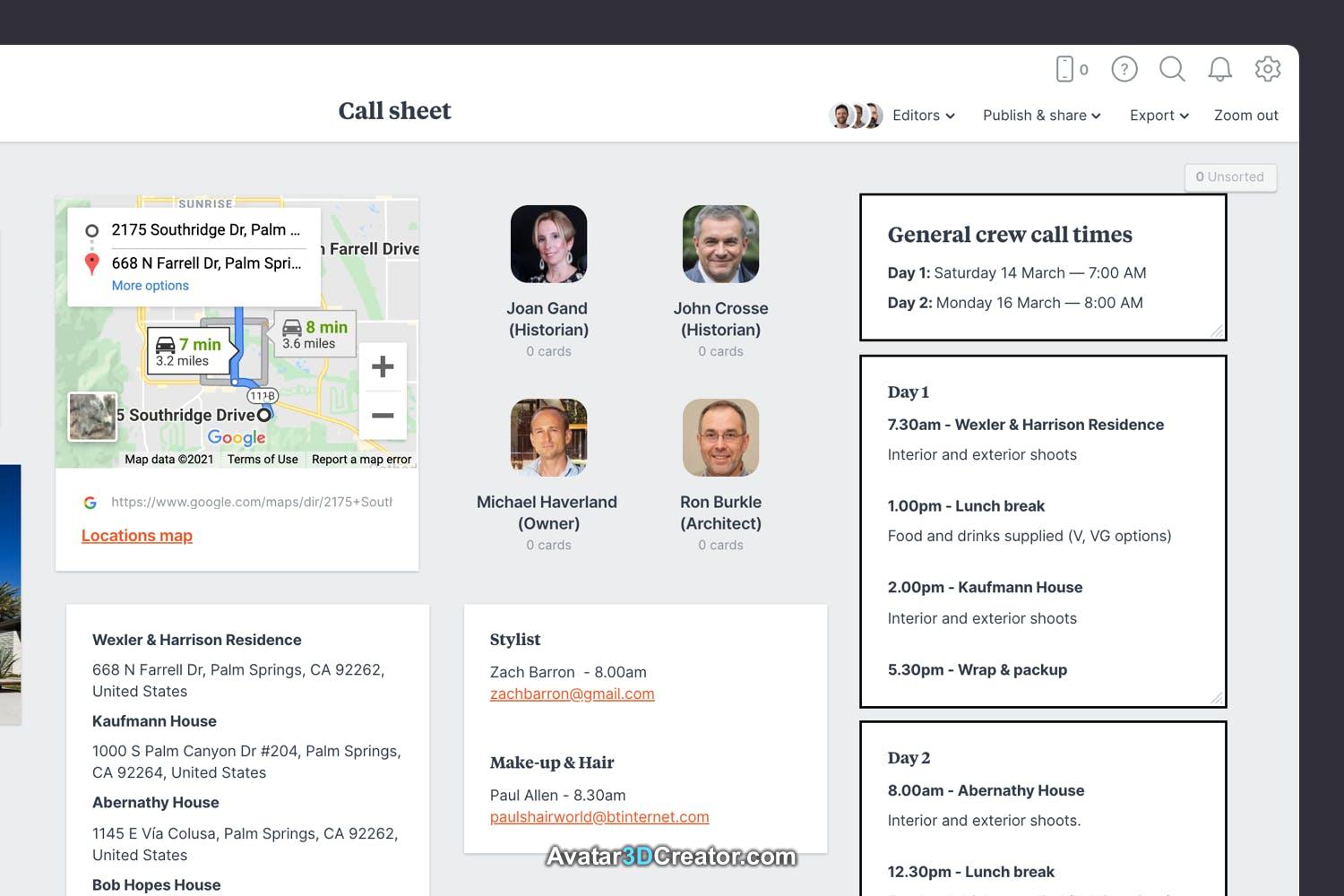
How to do this in Milanote
- Add a note to describe each activity on the schedule.Show me how
Refine & share with your team
Once you have everything you need, it’s time to organize your call sheet so it’s easy to scan. Then share it with your team so everyone can start preparing for the shoot.

How to do this in Milanote
- Create a column for each part of your call sheet.Show me how
- Publish and share the call sheet with your team.Show me how
You’re all done!
Hopefully, this guide has helped you become more organized during the pre-production stage. If you’re just starting a new shoot, use the Film Pre-production Plan template below to get set up in minutes.